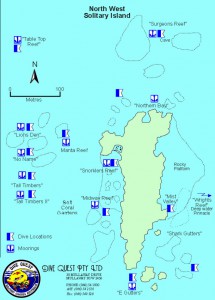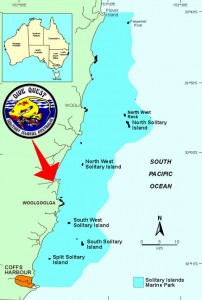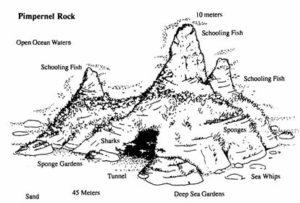Solitary Islands Dive Sites
 North Solitary Island
North Solitary IslandIs the largest of the Solitary Islands group and strongly influenced by the warm waters of the East Australian Current. The island has dives around its circumference and offers a large variety of dives to suit different conditions and preferences
Anemone Bay
Among the vast array of marine life to be found at this dive site are schools of pelagic fish, Eagle rays, Grey nurse sharks, and turtles cruising over the dense beds of Anemones and their beautiful Anemone fish interspersed with numerous varieties of corals decorated with tropical fish. This site is one of our most popular and has something to offer divers of all levels. Depth 5 – 24 metres.
The Steps
A rocky drop-off 100 m out from Anemone Bay, usually patrolled by Grey nurse sharks, Black cod, Eagle rays and Bull rays. There are also large and beautiful Black coral trees and Sea whips to be seen. Depth 5 – 24 metres.
The Canyons
A multi-coloured aquarium of tropical fish and bottom life, and a very popular spot for Spanish dancers, Blue tang and Coral cod. Depth 5 – 24 metres
The Bubble Cave
Fingers of coral covered rocky outcrops protrude southward in this area. Following these to the north leads to a cave in 8 metres of water and extends over 20 metres into the island. Depth 5 – 24 metres.
North West Rock “Fish Soup”
Approximately 2 km north of North Solitary Island, this rock is exposed and is in a current line. It offers superb fish life and spectacular swim throughs. Divers swim through a split in the outcrop to enter one of the most densely populated and diverse range of fish likely to be seen anywhere!! Bream, Tarwhine, Morwong, Mangrove jacks, Spangled emperors, Mosses perch, Black cod, Trevally, Blue groper, Flute-mouths and Sweetlips to name a few literally swarm divers as they explore this significant fish dive. Depth 5 – 24 metres.
 North West Solitary Island (Single or double dive)
North West Solitary Island (Single or double dive)
North West Solitary Island is a short distance offshore and offers relaxing diving and snorkelling. The dives offered here consist of rocky fingers and sandy gutters – an excellent location for hard and soft corals. Humpback whales are regulars during the winter migration.
Manta Reef
A very easy dive with a variety of hard and soft corals, tropical fish and visits by our magnificent Manta Rays between January and June. Depth 5 – 24 metres.
Wrights Reef
A pinnacle beginning in 33 metres and rising to 15 metres from the surface. A cave runs through the bommie at 27 metres containing resident Lion fish, and frequent visitors include Grey nurse sharks, large cod and Jewfish, as well as the ever popular Kingfish. Sea whips and Gorgonian fans adorn the walls as well. Depth 20 -30 metres
 South West Solitary (Groper) Island
South West Solitary (Groper) IslandThe western side of the island has a high cover of various types of plate corals, some quite large. The large resident schools of Morwong, Sweep and Surgeon fish attract large predators and often large Kingfish, Tailor and Mackerel can be seen. As the name suggests, a growing population of Blue groper exists which regularly accompany divers. The depth varies between 5 – 25 metres.
Pimpernel Rock
|
A really great dive site is further north than North Solitary Island. Pimpernel Rock is located off Sandon Point in Yuragyir National Park. It is 44 kilometres from Arrawarra Headland (where we launch the dive boat). Pimpernel Rock is one of those legendary sites that local and visiting divers rave about. BUT because of the distance to travel and the potential for strong currents at the site, it is a site that we don’t get to dive often. The site itself consists of a rock pinnacle that has three summits that are shaped like roadside safety cones – the largest one comes from over 40 metres up to less than 10 metres while the others come up to 15 to 20 metres. One of the features that makes this site even more special is that there is a tunnel running though the bottom with a smaller tunnel off to the right.
The fish life is amazing with large pelagic, Grey Nurse and just about every schooling fish imaginable.
|
South Solitary Island
South Solitary Island well known for the now disused Lighthouse and buildings set at the highest elevation on the southernmost end, 58 metres above the Pacific Ocean, pinpointing the magical location above and below the water.
Situated about a 40 minute boat ride from the launch site at Arrawarra, the island is exposed to the blue water currents blending tropical waters from the north with temperate waters from the south.
Find ‘all things big’ at South Solitary, including “big” fish, such as schooling pelagics, Grey Nurse Sharks and the Giant Cuttlefish. Additional marine life found around South Solitary Island include Blue Gropers, Wobbygongs, Shovelnose Rays, Bull Rays, Eagle Rays, Loggerhead Turtles, Frogfish, Anglerfish, King Fish, Bannerfish, Jewfish, Trevally, Wrasses, Moray Eels, Giant Cuttlefish, Blue Tangs, Clownfish, Nudibranchs. The list goes on.
There are six dive sites located around the South Solitary Island which, along with the other islands in the marine Park, provide some of the best dive locations dive locations in NSW.
Your Title Goes Here
Your content goes here. Edit or remove this text inline or in the module Content settings. You can also style every aspect of this content in the module Design settings and even apply custom CSS to this text in the module Advanced settings.



